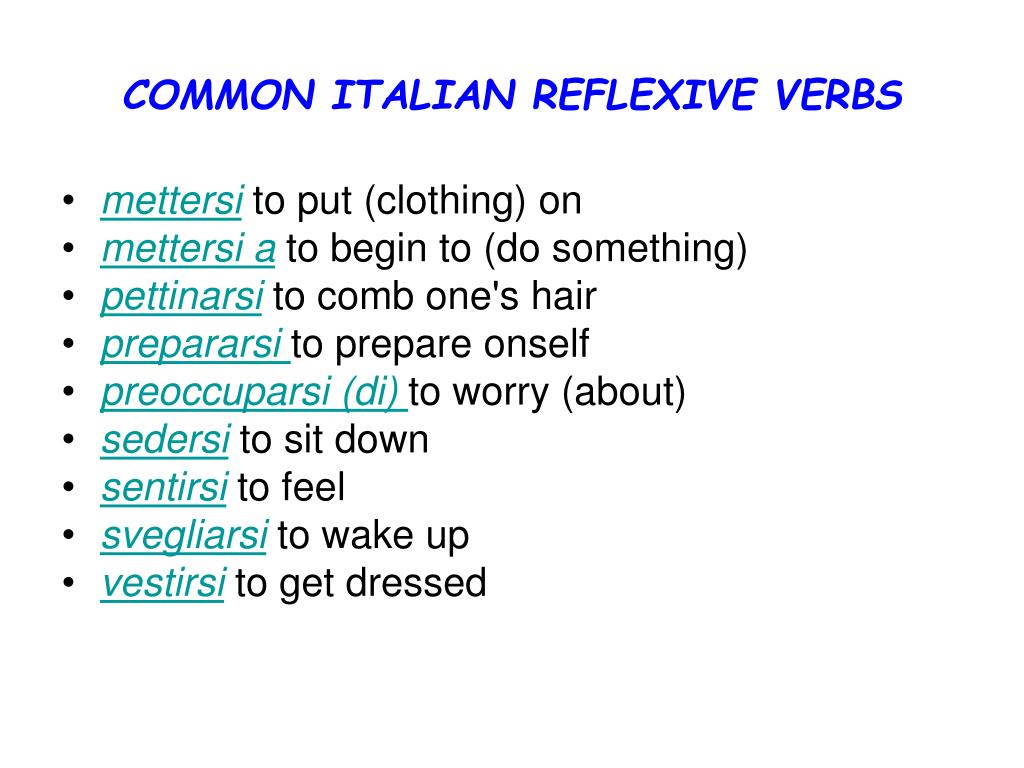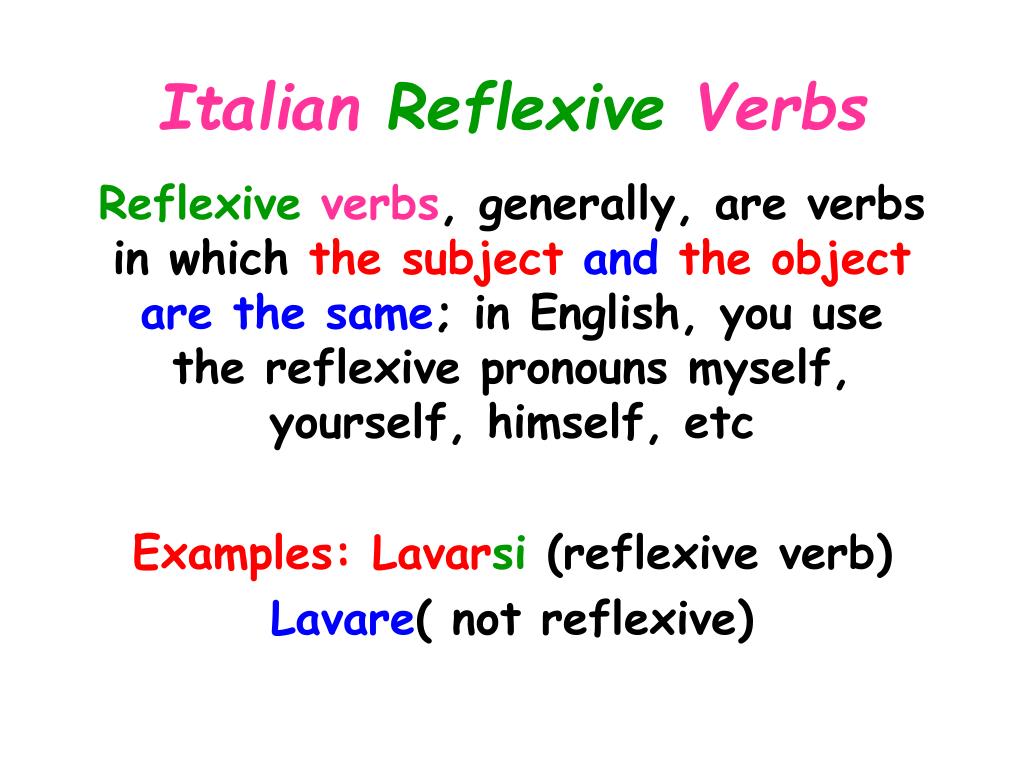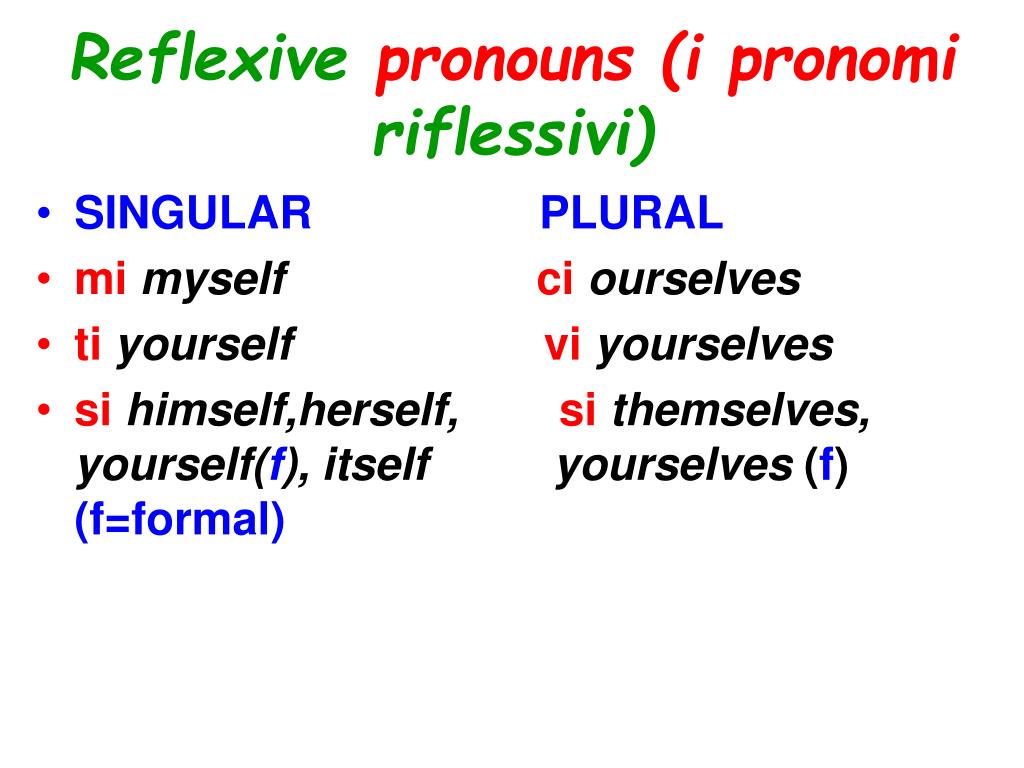
Italian reflexive verbs and how to use them YouTube
A reflexive verb may be used when the direct object and the subject are one and the same. The action performed by the subject affects the subject itself and is therefore reflexive. Another easy way to understand reflexive verbs is to think about the direct meaning of reflexive verbs, which is "verbs that reflect".

Reflexive Verbs in Italian what are they and how to use them?
Verbs that are reflexive in English, such as to hurt oneself or to enjoy oneself are reflexive in Italian. In addition, many verbs that include get, for example to get up, to get dressed, to get annoyed, to get bored, to get tanned, are reflexive verbs in Italian. Here are some important Italian reflexive verbs: Si accomodi! Take a seat!

Italian Passato Prossimo with Reflexive Verbs Grammar & Etsy Australia
Reflexive verbs are verbs that require a reflexive pronoun in their conjugation and their default form (the infinitive). The reflexive pronoun reflects the action of the verb back to the subject. For example: Svegliarsi = to wake oneself up Divertirsi = to have fund Arrabbiarsi = to get mad

I verbi riflessivi reflexive verbs italian,
In reflexive sentences, Italian verbs, like English verbs, are conjugated with reflexive pronouns. Reflexive pronouns ( i pronomi riflessivi) are identical in form to direct object pronouns, except for the third person form si (the third person singular and plural form). The following table includes the reflexive pronouns in Italian.

TOP 25 Reflexive Verbs Italian MOST USED Reflexive Italian Verbs List
Italian reflexive verbs are important because you need them to be able to esprimerti (express yourself) fluently. How To Conjugate Italian Reflexive Verbs. Let's practice conjugating Italian reflexive verbs, in other words, putting them into the right forms according to verb tenses or person.

How to use reflexive verbs in Italian (+ a list of most used ones
(Download) What Makes an Italian Verb Reflexive First and foremost, reflexive verbs are followed by the pronoun si in their infinitive form. Si means "to oneself" and it lets us know that the verb (the action) is being done to the person performing the action (the subject).

PPT Italian Reflexive Verbs PowerPoint Presentation, free download
Check out my Beginner's Course here: https://bit.ly/3bSxYWoLearn Reflexive verbs in Italian with me! In today's lesson you will learn how and when to use ref.

PPT Italian Reflexive Verbs PowerPoint Presentation, free download
Reflexive verbs, or verbi riflessivi, as they are called in Italian, are a subset of intransitive verbs of the pronominal family whose action is carried out by the subject and received by the subject. Think of washing yourself or getting dressed.

The present tense of the reflexive verb "SVEGLIARSI" (to wake up
Learn reflexive verbs in Italian with these exercises. Start with simple verbs like 'lavarsi', 'vestirsi', and 'alzarsi'. Incorporate pronouns when you practice, like 'Mi voglio vestire bene' or 'Si ricorda sempre di lavarsi le mani'. Try using reflexive verbs in various tenses - past, future, conditional.

THE REFLEXIVE VERBS IN ITALIAN! YouTube
In the reflexive form, the verb is preceded by a particle ( mi -myself, ti - yourself, si -him/herself/themselves, ci -ourselves, vi - yourselves) that stands for the direct object, which in the case of reflexive verbs is the same as the subject.

The present tense of the reflexive verb “LAVARSI” (to wash yourself)
Vocabolario How many reflexive verbs do you already know? With our vocabulary list you can learn 30 useful reflexive verbs! Do you remember how these verbs work? Read our lesson about reflexive verbs in Italian. Reflexive verbs in Italian LISTA VOCABOLI PDF Exercise with our Vocabulary Trainer GO TO THE VOCABULARY TRAINER BACK TO THE CORSO

PPT Italian Reflexive Verbs PowerPoint Presentation, free download
Reflexive verbs express an action that refers to the subject. The reflexive pronoun represents either the direct object (chi? who?) or the indirect object (a chi? to whom?) of the sentence. The subject and the object are the same person. They can also have mutual value: Ci vediamo domani. We see us tomorrow. I see you and you see me.

ITALIAN REFLEXIVE VERBS LIST FREEBIE 1 Teaching Resources
Sample Conjugations As you can see, reflexive verbs are conjugated just like non-reflexive verbs, according to their standard -are, -ere, or -ire endings. Remember when choosing the correct reflexive pronoun, it must correspond to the subject pronoun (see chart above!).

PPT Italian Reflexive Verbs PowerPoint Presentation, free download
Italian Grammar Italian Reflexive Verbs - An Easy Guide What is an Italian reflexive verb? A reflexive verb, in Italian verbo riflessivo, is a verb that ends in -si in its infinitive form (the ''to'' form).

ITALIAN REFLEXIVE VERBS REFERENCE LIST Italian words, Learning
For reflexive verbs, the reflexive pronoun indicates that the subject of the verb is performing the action on him/her/itself, rather than on someone or something else. The majority of reflexive verbs have to do with one's body, clothing, or relationships. - Lawless Italian

PPT I VERBI RIFLESSIVI > REFLEXIVE VERBS PowerPoint Presentation
Andrew Michael Italian Kitchen, 712 W Brookhaven Cir, Memphis, TN 38117, Mon - 4:30 pm - 9:00 pm, Tue - 4:30 pm - 9:00 pm, Wed - 4:30 pm - 9:00 pm, Thu - 4:30 pm - 9:00 pm, Fri - 4:30 pm - 10:00 pm, Sat - 4:30 pm - 10:00 pm, Sun - Closed